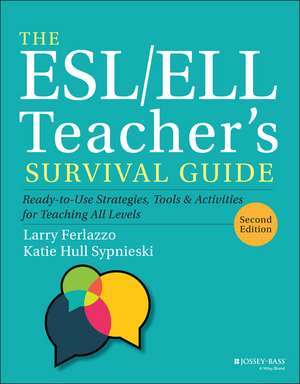The ESL/ELL Teacher′s Survival Guide: Ready–to–Use Strategies, Tools, and Activities for Teaching En glish Language Learners of All Levels, 2nd Edition: J-B Ed: Survival Guides
Autor L Ferlazzoen Limba Engleză Paperback – 22 mai 2022
Preț: 204.48 lei
Nou
Puncte Express: 307
Preț estimativ în valută:
39.13€ • 40.96$ • 32.38£
39.13€ • 40.96$ • 32.38£
Carte disponibilă
Livrare economică 15-29 martie
Livrare express 01-07 martie pentru 66.79 lei
Preluare comenzi: 021 569.72.76
Specificații
ISBN-13: 9781119550389
ISBN-10: 1119550386
Pagini: 576
Dimensiuni: 219 x 277 x 27 mm
Greutate: 1.29 kg
Ediția:2nd Edition
Editura: JOSSEY BASS
Seria J-B Ed: Survival Guides
Locul publicării:Hoboken, United States
ISBN-10: 1119550386
Pagini: 576
Dimensiuni: 219 x 277 x 27 mm
Greutate: 1.29 kg
Ediția:2nd Edition
Editura: JOSSEY BASS
Seria J-B Ed: Survival Guides
Locul publicării:Hoboken, United States
Descriere scurtă
Cuprins
About the Authors vii Acknowledgments xv About the Contributors xvii Introduction xxi PART ONE: GETTING STARTED WITH ENGLISH LANGUAGE LEARNERS 1 1 ELL Instruction: The Big Picture 3 ELL Population Growth 4 How Are English Language Learners Described? 5 Adolescent English Language Learners 7 A Primer on ELL Research 8 A Quick Tour of ELL Best Practices 12 2 ELL Classroom Basics: Building a Positive and Effective Learning Environment 17 The First R: Building Relationships 18 The Second R: Resources in the ELL Classroom 36 The Third R: Establishing Routines 43 PART TWO: TEACHING BEGINNING ENGLISH LANGUAGE LEARNERS 47 3 Key Elements of a Curriculum for Beginning ELLs 49 Key Elements of a Curriculum 50 4 Daily Instruction for Beginning ELLs 115 Picture Word Inductive Model Unit Plan 116 PART THREE: TEACHING INTERMEDIATE ENGLISH LANGUAGE LEARNERS 161 5 Key Elements of a Curriculum for Intermediate ELLs 163 Key Elements of a Curriculum 164 6 Daily Instruction for Intermediate ELLs 213 Designing Thematic Genre Units 213 A Sample Unit: Problem-Solution 215 Sample Lesson Plans 245 Inductive Lesson Plan 245 Using Text to Generate Analytical Writing Lesson Plan 251 A Sample Week in a Two-Period Intermediate ELL Class 258 PART FOUR: TEACHING ENGLISH LANGUAGE LEARNERS IN THE CONTENT AREAS 263 7 English Language Learners in the Mainstream Classroom 265 What Is the Organizing Cycle? 267 8 Teaching Social Studies 283 Building Relationships with Students 284 9 Teaching Science 301 Introduction: Science and Language 302 10 Teaching Math 315 Introduction 316 Challenge: Reading Mathematics Texts 317 Challenge: Knowledge of Appropriate Academic Vocabulary 319 Challenge: Participating in Mathematics Conversations 321 Challenge: Understanding Abstract Concepts 324 PART FIVE: WORKING WITH SPECIFIC GROUPS OF ENGLISH LANGUAGE LEARNERS 327 11 Supporting Long-Term English Language Learners 329 Who Are Long-Term English Language Learners? 330 How Can We Best Support LTELLs? 330 How Did Larry and His School Try to Put These Recommendations into Action? 331 12 Working with Elementary ELLs 339 Who Are Elementary English Learners? 340 Do Elementary English Language Learners Have Different Needs? Does Their Instruction Need to be Different from that of Older English Learners? 342 Program Types in Elementary 342 The Core Elements of Supportive Instruction for Elementary English Language Learners 345 What Does a Model Classroom that is Highly Supportive of Elementary English Learners Look Like? 345 What Does a Model Classroom that is Highly Supportive of Elementary English Learners Sound Like? 347 What Does a Model Classroom that is Highly Supportive of Elementary ELLs Feel Like? 349 Instructional Strategies that Support Elementary ELLs 352 13 Teaching Adult Ells 355 The Differences in Teaching English to Adults Versus Children 356 How to Foster Success with Adult Learners 362 14 Teaching ELLs with Learning Differences 371 Considerations for Further Investigation 372 Considerations for Determining Services 373 Considerations for Placement/Scheduling 375 Resources 376 PART SIX: FURTHER STRATEGIES TO ENSURE SUCCESS 377 15 Culturally Responsive and Sustaining Teaching 379 What Is Culturally Responsive and Sustaining Teaching? 380 The Organizing Cycle 381 16 Addressing Additional Opportunities and Challenges 393 Student Motivation 394 The Advantages of Being Bilingual or Multilingual Lesson Plan 395 Social Emotional Learning 408 Textbook Integration 410 Error Correction 412 Limited Access to Educational Technology 414 Multilevel Classes 415 Co-Teaching and/or Working with an Aide/Paraprofessional 419 Classroom Management 421 Book Selection 422 Supporting ELL Students with Limited or Interrupted Formal Education (SLIFEs) 424 17 Home Language of ELLs 427 Seeing Home Language as an Asset 429 A Mini Lesson on the Value of Home Languages 430 Research on Home Languages in the Classroom 431 Turning Bloom's Taxonomy into a Home-Language Framework 434 Abandoning English-Only Policies 440 Conclusion 442 18 Using Learning Games in the ELL Classroom 445 Research Support 445 What Are the Qualities of a Good Learning Game? 446 19 Assessing English Language Learners 461 Assessing ELLs: Key Principles 462 20 Reflective Teaching/Professional Development 487 The Bread in the Pond 487 Why Should We Have an Intentional, Formal Process for Reflecting? 488 Why I Began Filming Myself and Why I Continued 489 Adopting a Reflective Mindset 490 Afterword 497 Notes 499 Index 539
Notă biografică
Larry Ferlazzo teaches English Language Learners and English-proficient students at Luther Burbank High School in Sacramento, California. He is the author or editor of twelve books on education, and writes a weekly teacher advice column for Education Week. Katie Hull Sypnieski teaches English Language Learners and English-proficient students at Arthur A. Benjamin Health Professions High School in Sacramento, California. She is a Teacher Consultant with the Area 3 Writing Project at the University of California, Davis and is a co-author of The ELL Teacher's Toolbox and Navigating the Common Core with English Language Learners.













